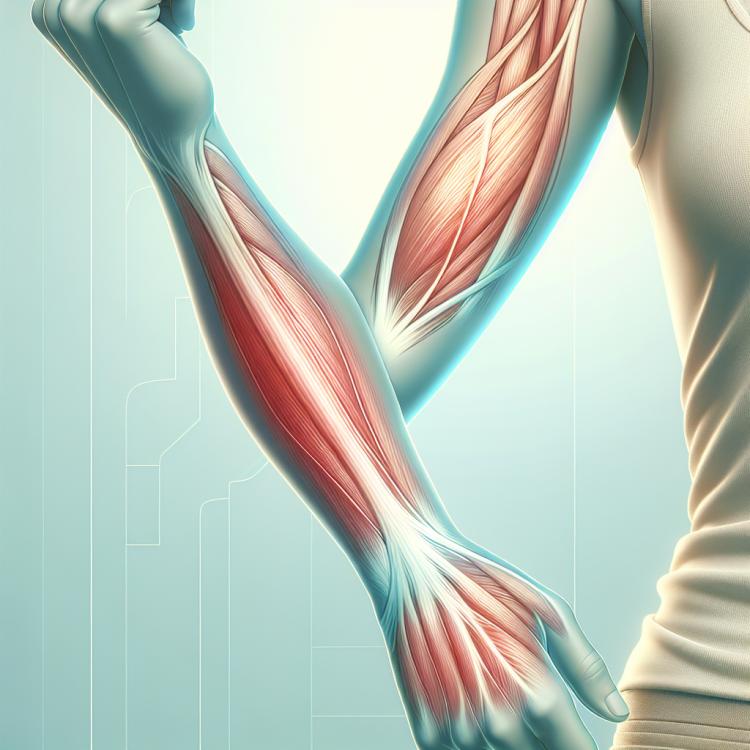
Cramps in the forearms: causes, treatment, and prevention
About the symptom
Forearm cramps are involuntary muscle contractions that can cause discomfort and pain. These episodes can occur both at rest and during physical activity, often affecting one side of the body. Cramps can last from a few seconds to several minutes and can cause a sharp feeling of discomfort, which can significantly impact a person’s quality of life. It is important to note that such cramps can be either a temporary phenomenon or a sign of more serious medical conditions.
Among the main symptoms of forearm cramps, one can highlight: acute pain in the forearm area, a feeling of intense tension in the muscles, and a general sense of fatigue. Patients often also report an inability to control muscle contractions, leading to limited movement and difficulty in performing everyday tasks. If cramps occur regularly or are accompanied by other alarming symptoms such as numbness, tingling, or weakness in the limbs, it is important to consult a doctor for diagnosis and to determine the causes of these manifestations.
Diseases
Cramping in the forearms can be a symptom of various diseases that require attention and medical diagnosis. In some cases, they may be a temporary phenomenon related to physical exertion or stress, but if cramps occur regularly, this may indicate serious deviations in health. For example, diseases of the nervous system, such as peripheral neuropathy or multiple sclerosis, can cause spasms and muscle cramps in various parts of the body, including the forearms.
Additionally, cramps in the forearms may be associated with problems in the vascular system. Ischemia, arising from the narrowing of blood vessels or the formation of clots, can lead to insufficient blood supply to the muscles and, in turn, to their contraction in the form of cramps. Furthermore, some endocrine diseases, such as hypoparathyroidism or diabetes, can affect the electrolyte balance in the body, which may also lead to the occurrence of cramps.
List of diseases:
- Peripheral neuropathy
- Multiple sclerosis
- Ischemic disease
- Hypoparathyroidism
- Diatheses and metabolic disorders
- Diabetes mellitus
- Degenerative spine diseases
Diagnosis
The diagnosis of forearm cramps is a multifaceted process that requires a comprehensive approach. Initially, the specialist conducts a detailed medical history: determining the frequency, duration, and presence of provoking factors for the occurrence of cramps. It is also important to consider accompanying symptoms, such as pain, numbness, or weakness, as they may indicate various causes. A physical examination allows the doctor to assess the condition of the muscles and joints, as well as to conduct tests on functionality and reflexes.
For more accurate diagnosis, instrumental studies are often required. These may include X-rays, MRI, or ultrasound, which help to rule out injuries, joint pathologies, or vascular diseases. Laboratory tests, including a complete blood count and biochemistry, also play an important role in diagnosis by identifying possible metabolic disorders, such as electrolyte deficiency or thyroid function impairment.
- Complete blood count
- Biochemical blood analysis
- Electrolyte profile
- ECG (electrocardiogram)
- X-ray of the forearm
- Ultrasound of the soft tissues of the forearm
- Magnetic resonance imaging (MRI)
- Neuromuscular tests (e.g., EMG)
Which doctor to consult
Forearm cramps can be caused by various factors, and to effectively treat this symptom, it is important to determine the medical direction. It is recommended to start by consulting a therapist, who will conduct an initial examination and refer to specialized specialists if necessary. The therapist will be able to assess the patient’s overall health, identify possible causes of the cramps, and direct them to necessary examinations.
Depending on the suspected diagnosis, the patient may be referred to a neurologist if the cramps are related to nervous system disorders, or to an orthopedist if the cause is damage to the musculoskeletal system. It is also worth considering a consultation with an endocrinologist, as cramps can be a result of metabolic disorders, namely electrolyte deficiencies. Additionally, rehabilitation doctors can help in restoring muscle function and improving the patient’s overall condition.
- Therapist
- Neurologist
- Orthopedist
- Endocrinologist
- Rehabilitation doctor
Types of Forearm Cramps
Forearm cramps come in various types, and their classification can depend on different factors such as the cause of occurrence, duration, and intensity. One of the main types is spontaneous cramps, which occur without a visible reason and can be triggered by fatigue, mineral deficiencies, or prolonged static positions. Typically, these cramps resolve on their own within a few minutes.
Another type is cramps caused by physical strain, for example, during intense workouts or after prolonged work with arm load. These cramps can be quite painful but are usually temporary and disappear after rest and relaxation. In rare cases, forearm cramps can be a symptom of more serious conditions, such as neurological disorders or metabolic disturbances.
- Spontaneous cramps
- Cramps caused by physical strain
- Cramps related to neurological diseases
- Cramps associated with mineral deficiencies
- Cramps occurring after prolonged stress
Causes of Forearm Cramps
Forearm cramps can be caused by a variety of factors, both physiological and pathological. One of the most common causes is muscle strain, which occurs as a result of prolonged work at a computer, engaging in sports, or performing monotonous tasks that require intensive use of the hands. Muscle spasms can also occur when there is insufficient physical training, when the muscles are not prepared for high loads.
In addition, forearm cramps can result from various medical conditions and diseases. For example, a deficiency of electrolytes such as potassium, magnesium, and calcium can also lead to spasms. Conditions related to the nervous system, such as peripheral neuropathy, can also cause similar symptoms. Moreover, factors such as dehydration, lack of sleep, and stress can contribute to the occurrence of cramps in the forearms.
- Muscle strain
- Electrolyte deficiency
- Peripheral neuropathy
- Dehydration
- Lack of sleep
- Stress and strain
Common Related Pathologies
Forearm cramps can be a symptom of various diseases and conditions that require attention. One common pathology is carpal tunnel syndrome, where the median nerve is compressed in the wrist area. This can cause not only cramps but also numbness, tingling, and pain in the forearm and hand. In this condition, it is important to conduct timely diagnosis and treatment to avoid further deterioration of the state.
Another possible cause of cramps in the forearms is shoulder-scapular periarthritis, which is accompanied by inflammatory processes in the shoulder joint area. In this case, cramps may arise due to tension and muscle spasms, which also requires a comprehensive approach to therapy, including medication and physiotherapy.
Finally, conditions such as diabetic neuropathy and hypothyroidism can cause cramps in the limbs, including the forearms. These conditions require special attention from specialists and comprehensive treatment aimed at managing the underlying disease and alleviating symptoms.
- Carpal tunnel syndrome
- Shoulder-scapular periarthritis
- Diabetic neuropathy
- Hypothyroidism
- Spinal dysfunctions
- Myasthenia
Expert Opinion
Forearm cramps are a symptom that can indicate various diseases and conditions requiring a careful approach to diagnosis and treatment. In medical practice, it is important to understand that cramps can be either a one-time occurrence due to physical exertion or stress, or a sign of more serious illnesses. Experts recommend not to ignore recurring cases of cramps and to seek medical attention in a timely manner to identify the cause.
It is important to note that forearm cramps may be associated with electrolyte imbalance, nervous system disorders, as well as with professional strain on the arm in certain fields of activity such as sports or working with small objects. Consultation with a neurologist or general practitioner can help in establishing a diagnosis and prescribing appropriate treatment. Regular monitoring and prevention are also key factors in preventing recurrences and maintaining normal bodily function.

Treatment of Forearm Cramps
The treatment of forearm cramps depends on their cause and frequency of occurrence. It is important to note that if cramps occur frequently and are accompanied by painful sensations, this may indicate more serious pathologies that require medical intervention. In most cases, relieving the condition may be sufficient to change lifestyle, improve nutrition, and increase physical activity. Special stretches and exercises can help relax the muscles and prevent the occurrence of cramps.
If forearm cramps become regular and hinder daily life, a doctor may recommend additional procedures. This may include physiotherapy to strengthen the muscles and improve their elasticity, as well as massage to relieve tension. In some cases, painkillers and anti-inflammatory medications may be prescribed to eliminate pain syndrome, if present.
It is also important to monitor hydration and ensure that the body receives an adequate amount of necessary vitamins and minerals, as their deficiency can also lead to cramps. A doctor may recommend calcium and magnesium supplements, as well as B vitamins, which play a key role in the functioning of the nervous system and muscles.
- Physiotherapy
- Massage
- Stretching exercises
- Diet change
- Intake of vitamins and minerals
- Painkillers
Complications
Forearm cramps, while seeming like a temporary and trivial issue, can lead to serious complications, especially if they occur regularly. Repeated cramps may indicate the presence of deeper diseases or disorders, such as circulation problems, neurological disorders, or electrolyte imbalances. In such cases, it is essential not to ignore the symptoms and consult a doctor to identify the underlying cause.
Moreover, persistent cramps can limit movement and reduce the patient’s quality of life. This can lead to muscle weakness or even muscle atrophy in the arms. It is important to remember that cramps can cause not only physical pain but also psychological pressure, leading to anxiety and depression in patients who fear recurrent attacks.
If timely measures for diagnosis and treatment are not taken, forearm cramps can lead to a number of complications, including:
- Deterioration of hand functionality
- Decline in quality of life
- Development of chronic pain
- Muscle atrophy
- Psychological issues such as anxiety and depression